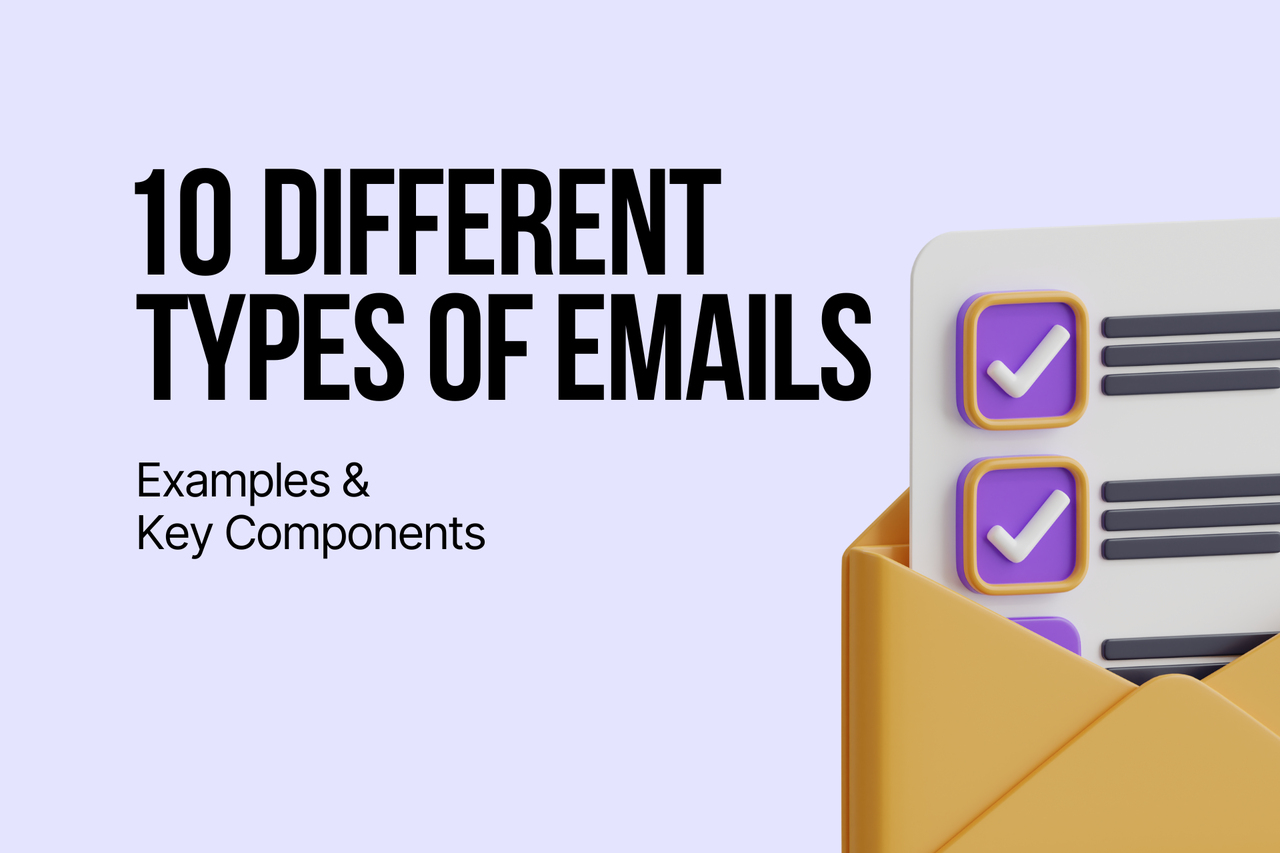What are the Different Types of Emails?
We're all familiar with different email types, from welcoming new users to resetting passwords.
As we said, each type serves a unique purpose and requires specific language, tone, and timing.
Organizing these emails according to their role in the customer journey, a strategy often used in lifecycle marketing helps ensure effective and timely communication.
This way, we avoid sending onboarding emails to our loyal customers. 🙃
Here are the ten main types of emails & their subtypes you can send to your customers:
1. Welcome Emails
- Thank You Emails (Simple Welcome)
- Welcome Email with Incentive
- Educational Welcome Email
- Welcome Email Series
2. Onboarding Emails
- Product/Service Tour Email
- Value Proposition Email
- Step-by-Step Guide Email
3. Newsletters
- Informational Newsletters
- Promotional Newsletter
- Company Update Newsletter
- Curated Content Newsletter
4. Promotional Emails
- Discount Offers Emails
- Limited-Time Sales Emails
- Flash Sales
5. Seasonal Emails
- Seasonal Emails
- Holiday Emails
- Event-based Emails
- Special Day Emails
6. Transactional Emails
- Order Confirmation Emails
- Shipping Confirmation Emails
- Cart Abandonment Emails
- Password Reset Emails
- Account Activation Emails
- Subscription & Renewal Reminder Emails
- Appointment Reminders
7. Social Proof Emails
- User-Generated Content (UGC) Emails
- Customer Testimonials
- Case Studies
- Customer Milestones Emails
8. Announcement Emails
- New Product or Service Launch
- Event Announcements
- Policy or Terms Updates
- Partnership Announcements
9. Re-engagement / Win-Back Emails
- “We Miss You” Emails
- Feedback Request Emails
- Survey Emails
- FOMO Marketing Emails
10. Internal Emails
- Company Updates
- Project Updates
- HR Announcements
10 Types of Email Examples & Why They Are Effective
1. Welcome Emails
Welcome emails are the first messages you send to your new customers or subscribers. They're essential because they're the first impression someone gets of your company.
As per Campaign Monitor, welcome emails are read 42% more often than regular emails. That's a big deal! It means people are more interested in what you say when signing up.
These emails are a chance to say "thanks" for signing up and tell customers what they can expect from you. They can set the tone for the rest of your emails.
Here are the types of welcome emails to send to your subscribers:
- Thank You Emails (Simple Welcome): This email contains a warm greeting, a thank you note for the subscription, and a brief intro to your business.
- Welcome Email with Incentive: This starts with a greeting and thank you note, followed by showcasing a special offer or discount code that the subscriber can use.
- Educational Welcome Email: This email type starts with a greeting, providing helpful information or tips about your product or service.
- Welcome Email Series: This is a set of emails sent over time, each serving a different purpose - thanking the subscriber, offering incentives, providing information, and introducing your company in detail.
📩 Example of Welcome Email with Incentive from TheRealReal:

Key elements TheRealReal uses in its welcome email:
- Exclusivity: This welcome email highlights a "new member exclusive" feature at the start, giving the recipient a sense of special treatment.
- Immediate Offer: Putting a discount or offer upfront in the email rewards signups and nudges the recipient towards making their first purchase.
- Warm Welcome and Appreciation: Including a welcome note and a thank you message creates a positive impression, showing that the company values its community.
- Brand Commitment and Values: The email effectively shares the brand's commitment to quality and sustainability, letting customers know they're supporting a company whose values align with theirs.
Why it’s effective? This welcome email makes the new member feel unique, valued, and informed, and that's what we want in an effective welcome email.
🌟 Bonus: If you use Shopify, then you can use Shopify's welcome automation, which gives you three effective options to choose from: a simple one-time welcome, a series of timely reminders, or an engaging series of brand stories.
2. Onboarding Emails
Onboarding emails are crucial for guiding new customers or users through the initial stages of interacting with your product or service. These emails aim to educate and engage users, helping them get the most out of their purchase or subscription.
Effective onboarding can significantly reduce churn rates and boost customer satisfaction and loyalty.
Here are the types of onboarding emails you can send to your users:
- Product/Service Tour Email: This email serves as a virtual tour of your product or service, highlighting key features and benefits. It's designed to help new users navigate your offering and discover its value firsthand.
- Value Proposition Email: This email focuses on reinforcing why the customer made the right decision. It details the unique benefits and selling points of your product or service, aligning with the customer’s needs and expectations.
- Step-by-Step Guide Email: For more complex products or services, a step-by-step guide can be invaluable. Including visuals or links to video tutorials can further enhance the effectiveness of this email by providing clear, easy-to-follow instructions.
📩 Example of Onboarding Email / Step-by-Step Guide from Miro:
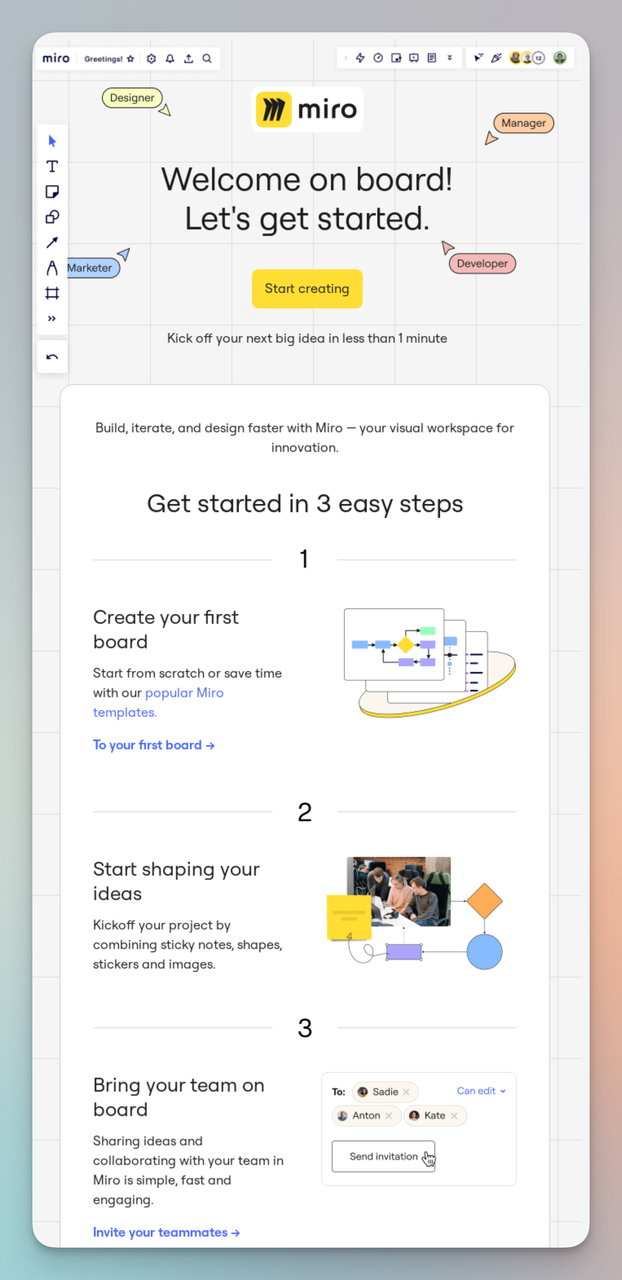
Key elements Miro uses in its onboarding email:
- Simplicity: The email is very straightforward, making it highly accessible for new users. By avoiding complexity, Miro ensures that newcomers don’t feel overwhelmed.
- Actionable Links: Miro cleverly incorporates direct links in the email, such as creating their first board. This allows users to start interacting with the product immediately, reducing barriers to engagement.
- Structured Steps: The email outlines clear, numbered steps for getting started.
Why it’s effective? Because it is user-focused. It simplifies onboarding, promotes immediate product interaction, emphasizes critical features, and underscores the platform's collaborative capabilities.
3. Newsletters
Newsletter emails are vital for engaging audiences across various industries, including B2B and e-commerce. By delivering content that aligns with the interests and needs of your audience, newsletters help maintain customer engagement and establish your brand as a trusted information source.
As highlighted by Zapier, newsletters are increasingly popular among large businesses because they can reduce customer acquisition costs and provide a stable channel for direct customer engagement, independent of fluctuating ad costs or web traffic.
Here are the types of detailed newsletter emails you can include in your communications strategy:
- Informational Newsletters: These newsletters educate your audience about relevant topics, industry news, or helpful tips that align with their interests or needs.
- Promotional Newsletters: Tailored to drive sales and highlight special offers, promotional newsletters focus on your products or services and showcase featured items, bestsellers, or new arrivals. This format is trendy among ecommerce sites.
- Company Update Newsletters: This type of newsletter is excellent for building a community around your brand. Share behind-the-scenes stories, new hires, company achievements, or upcoming projects to keep your audience in the loop.
- Curated Content Newsletters: A mix of articles, videos, podcasts, resources, and a brief commentary on why they’re worth consuming.
📩 Example of Promotional & Informational Newsletter from Rains:

Key elements Rains uses in its newsletter email:
- Community Building: The newsletter starts by inviting new subscribers to join the Rains community, emphasizing the benefits and exclusive content they can expect. This creates a welcoming atmosphere and fosters a sense of belonging.

- Brand Credibility: By featuring their participation in the Paris Fashion Show, the newsletter leverages a high-profile event to enhance the brand's credibility and prestige in the fashion industry.
- Product Highlights: The newsletter showcases Rains' signature waterproof fabrics and new arrivals, educating customers about unique product features.
Why it’s effective? Rains' newsletter works because it makes readers feel part of a community, highlights their involvement in significant events and shows off what's unique about their products.
4. Promotional Emails
Promotional emails are a fantastic way to market your business and boost sales while attracting customer interest and improving brand visibility.
These emails are designed to encourage immediate action, making them an essential part of any digital marketing strategy.
They work by offering time-sensitive deals or exclusive offers that appeal to the consumer's desire for value.
Since they're so effective and popular, let's move with the different types of promotional emails that you can use to promote your business:
- Discount Offers Emails: These emails are crafted to entice customers by presenting them with a cost-saving opportunity. Typically, they highlight a percentage off, a buy-one-get-one deal, or a notable price drop.
- Limited-Time Sales Emails: These sales offer short-duration deals with a ticking clock. To make customers feel even more motivated to buy, they often include a countdown timer.
- Flash Sales Emails: Flash sales are sudden and, typically, massive discounts that last for an incredibly short time, like an hour.
📩 Example of Promotional Discount Offers Email from Pourri:
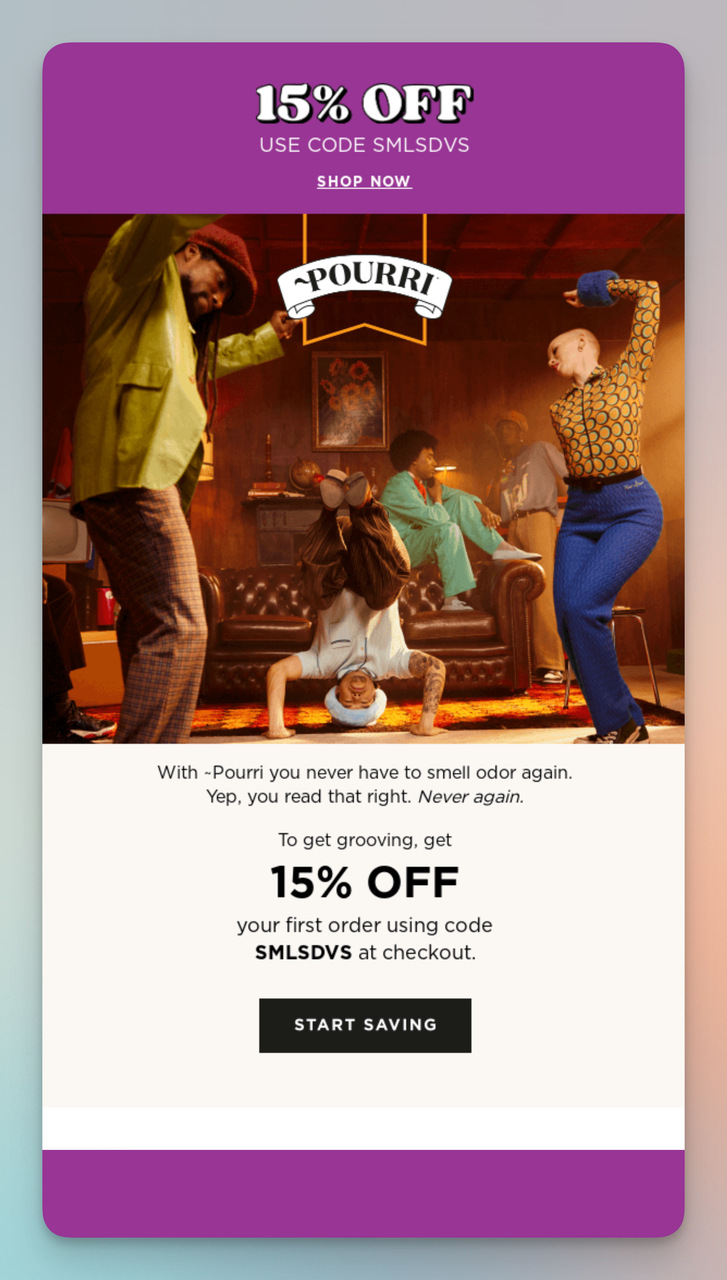
Key elements Pourri uses in its promotional email:
- Prominent Discount Display: The discount is displayed at the top and reinforced at the bottom, ensuring it's the first and last thing a reader sees. This strategy emphasizes the value of the offer.
- Catchy Tagline: The phrase starts with the "With Pourri you never have..." is catchy, humorous, and directly addresses a common problem, reinforcing the product's benefit in a lighthearted way.
Why it’s effective? It merges a striking design with a clear, value-packed offer, wrapped in an engaging copy that speaks directly to the consumer’s needs and sense of fun.
5. Seasonal Emails
Seasonal emails are a smart and strategic way of seasonal marketing campaigns that take advantage of the changing interests and needs of customers throughout the year.
These emails are customized to match specific seasons, holidays, events, or special days, offering timely content that resonates with the recipient's current experiences and celebrations.
Here are the types of Seasonal Emails you can send:
- Seasonal Emails: They reflect the changes in seasons: spring, summer, fall, and winter. They should offer content relevant to each season, such as seasonal products and services, maintenance tips, recipes, or activities.
- Holiday Emails: Includes email types such as Christmas, New Year's, Valentine's Day, or Thanksgiving emails.
- Event-Based Emails: These emails include major sales days like Black Friday, Cyber Monday, Singles' Day, and other significant shopping events.
- Special Day Emails: Special day emails focus on less commercial, more personal occasions like Mother's Day, Father's Day, or Earth Day.
📩 Example of Seasonal Spring Email from Casper:

Key elements Casper uses in its seasonal/spring email:
- Seasonal Relevance: The email aligns with the seasonal context by leveraging the warmer weather of spring. This is cleverly contrasted with their "Snow Technology" in mattresses, which implies cooling features beneficial during the warmer months.
- Engaging Subject Line: The spring email subject line "What's cooler than being cool?" is catchy and intriguing, encouraging recipients to open the email. It cleverly hints at the product’s unique selling proposition—the cooling technology.
- Promotional Offers: Including a "Spring Savings Sale" with discounts on mattresses and other products is a standard but effective strategy to stimulate sales. It leverages the common consumer behavior of refreshing households during the spring.
Why it’s effective? The email is well-designed with a clear message that effectively uses seasonal changes to promote a product that provides comfort against the upcoming heat.
6. Transactional Emails
Transactional emails are automated messages sent to users in response to specific actions they have taken. These emails are crucial because they provide timely information about actions affecting user interaction with a service or product.
Here are the types of transactional emails:
- Order Confirmation Emails: These emails provide proof of purchase and detail the customer's purchase. They should include an itemized list of products or services, prices, total cost, and any relevant order number for future reference.
- Shipping Confirmation Emails: A shipping confirmation email is sent after an order has been dispatched. This should include a tracking number, estimated delivery date, and a link to track the shipment.
- Cart Abandonment Emails: Sent to customers who have added items to their online shopping cart but exited without completing the purchase.
- Password Reset Emails: These emails are triggered when a user requests a password change. They should contain a secure link or instructions for resetting the password.
- Account Activation Emails: Essential for verifying that the email address provided during the signup process is valid and that the user has access to it. This email should include a verification link or code to activate the account.
- Subscription & Renewal Reminder Emails: They can include details of the subscription term, cost, and benefits and provide an option to renew or modify the subscription.
- Appointment Reminders: These emails are used by service-based businesses to remind customers of upcoming appointments. They often include the appointment's date, time, location, and options to confirm, cancel, or reschedule.
📩 Example of Order Confirmation Email from Haoma:

Key elements Haoma uses in its order confirmation email:
- Order Status: The email directly informs the customer that their order is on its way, which is the primary purpose of the email.
- Tracking Information: There is a prominent "TRACK YOUR ORDER" button, making it easy for customers to follow the progress of their delivery.
- Order Details: Includes an order number and a FedEx tracking number, which are crucial for referencing the order if the customer needs to contact customer support.
- Detailed Item List: The items in the shipment are listed with images, descriptions, and prices, which help confirm to the customer exactly what they should expect to receive.
Why it’s effective? Haoma’s order confirmation email serves its functional purpose of confirming an order, enhancing user trust, and encouraging further interaction with the brand.
7. Social Proof Emails
Social proof emails are a powerful way to leverage human psychology in marketing. When you send out social proof emails, you share stories about other happy customers who have already purchased and enjoyed your product or service. By doing this, you can build trust and credibility with your audience, which can also help convince them to try your product or service.
Here are the types of social proof emails:
- User-Generated Content (UGC) Emails: These are emails that show content made by your customers, like pictures they've taken of your products or reviews they've written. They show subscribers that real people are enjoying your products.
- Customer Testimonials: These emails feature positive reviews from your customers. A testimonial from a satisfied customer can often be more convincing than your sales pitch.
- Case Studies: Emails that detail the success story of a customer who used your product or service. It shows a real-life example of how your product can help solve a problem.
- Customer Milestones Emails: Emails celebrating a customer's anniversary or other notable event with your brand. It shows you value your relationship with your customers.
📩 Example of Social Proof Email from Magic Spoon:
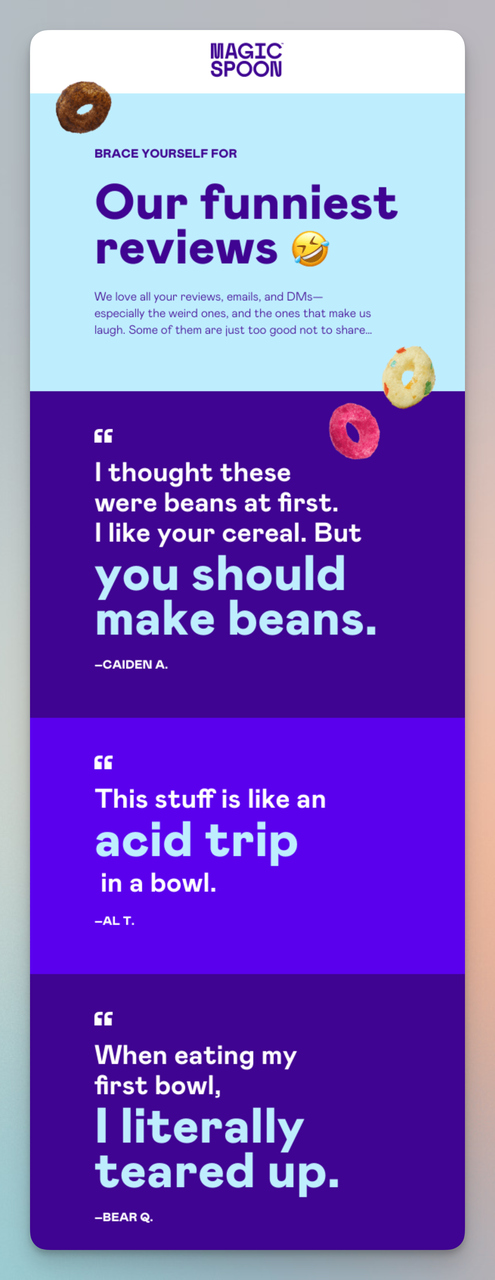
Key elements Magic Spoon uses in its customer testimonials email:
- Engaging Header: The email starts with a bold and playful header, "Brace yourself for our funniest reviews." This captures attention and sets a lighthearted tone.
- Humorous Testimonials: The testimonials selected are funny and quirky, reflecting the unique and fun brand personality of Magic Spoon. 😄 This not only makes the email entertaining but also memorable.
- Customer Names: Including the names of the customers (first name and last initial) personalizes the testimonials, making them more relatable and trustworthy.
Why it's effective? By combining these elements, Magic Spoon's email effectively uses social proof to create an engaging and persuasive message.
8. Announcement Emails
Announcement emails keep your customers in the loop about what's new and upcoming with your business. They build anticipation, generate interest, and can drive engagement or sales, depending on the nature of the news you're sharing.
Here are the types of announcement emails you can send to your subscribers:
- New Product or Service Launch: The email should create anticipation by describing the new product or service, its benefits, and the launch date. Visuals, such as images or videos, can make this email even more engaging.
- Event Announcements: Event announcement emails are used to inform your customers about upcoming events related to your business - whether these are webinars, sales events, workshops, or other special occasions. It should include all the necessary details like date, time, location(if applicable), and why the recipient should attend.
- Policy or Terms Updates: If there are updates to your company's terms of service or privacy policy, it's crucial to communicate this to your users efficiently with an announcement email. These emails must be clear, transparent, and to the point, explaining what has changed and how it may affect the user.
- Partnership Announcements: This email should explain what the partnership entails and how it will provide added value or benefits to your customers.
📩 Example of Policy or Terms Updates Email from Harry’s:
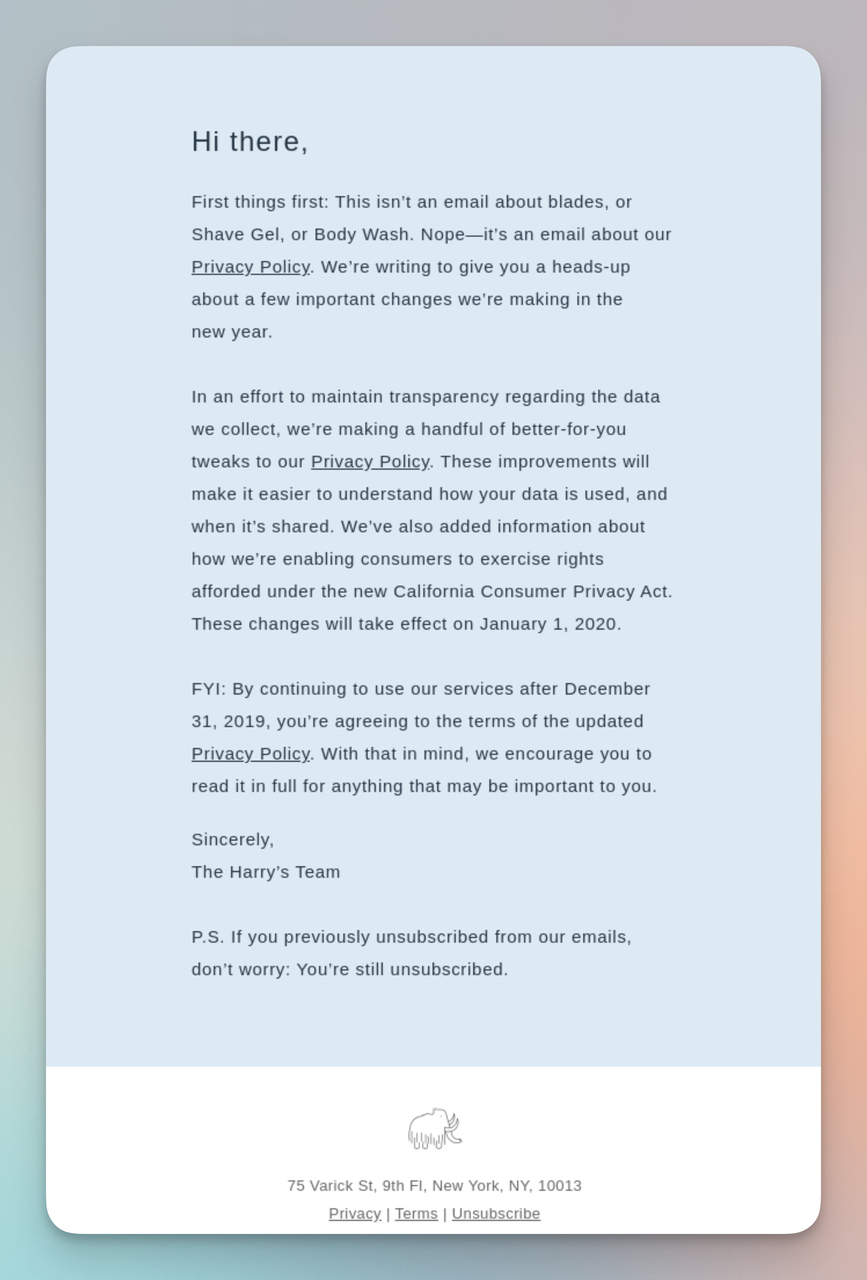
Key elements Magic Spoon uses in its policy update email:
- Clear Introduction: The email immediately clarifies its purpose, stating it's not about their usual products but about an update to the privacy policy. This sets the right expectations from the start.
- Friendly Tone: Unlike typical legal updates, which can be dry and impersonal, Harry's uses a friendly and conversational tone. This makes the information more accessible and less daunting for the reader. But this may only be suitable for some audiences.
- Transparency: The email details the nature of the changes to the privacy policy and why these changes are being made. It emphasizes transparency about how customer data is used, which helps build trust.
- Call to Action: The email encourages customers to read the full privacy policy to understand the details fully. This compelling call to action also helps ensure users are well-informed.
Why it's effective? By balancing friendliness with informational clarity, Harry's communicates important updates effectively without overwhelming or alienating their customers.
9. Re-engagement / Win-Back Emails
Re-engagement or win-back emails are aimed at customers or users who were once engaged but, over time, have become less active. The goal is to pique their interest and encourage them to re-engage with your product, service, or brand.
These emails are an opportunity to show your audience what they've been missing and a gentle nudge to invite them back.
Here are the types of re-engagement or win-back emails you can send to your subscribers:
- "We Miss You" Emails: Remind customers of exciting updates/offers and include a personal note.
- Feedback Request Emails: Provide a way for customers to share their thoughts about your product or service.
- Survey Emails: Provide a structured way for customers to share their thoughts and experiences.
- FOMO Marketing Emails: Create a sense of urgency or exclusivity with limited-time offers, exclusive deals, or popular items that are selling out fast.
📩 Example of Feedback Request Email from Tillamook:
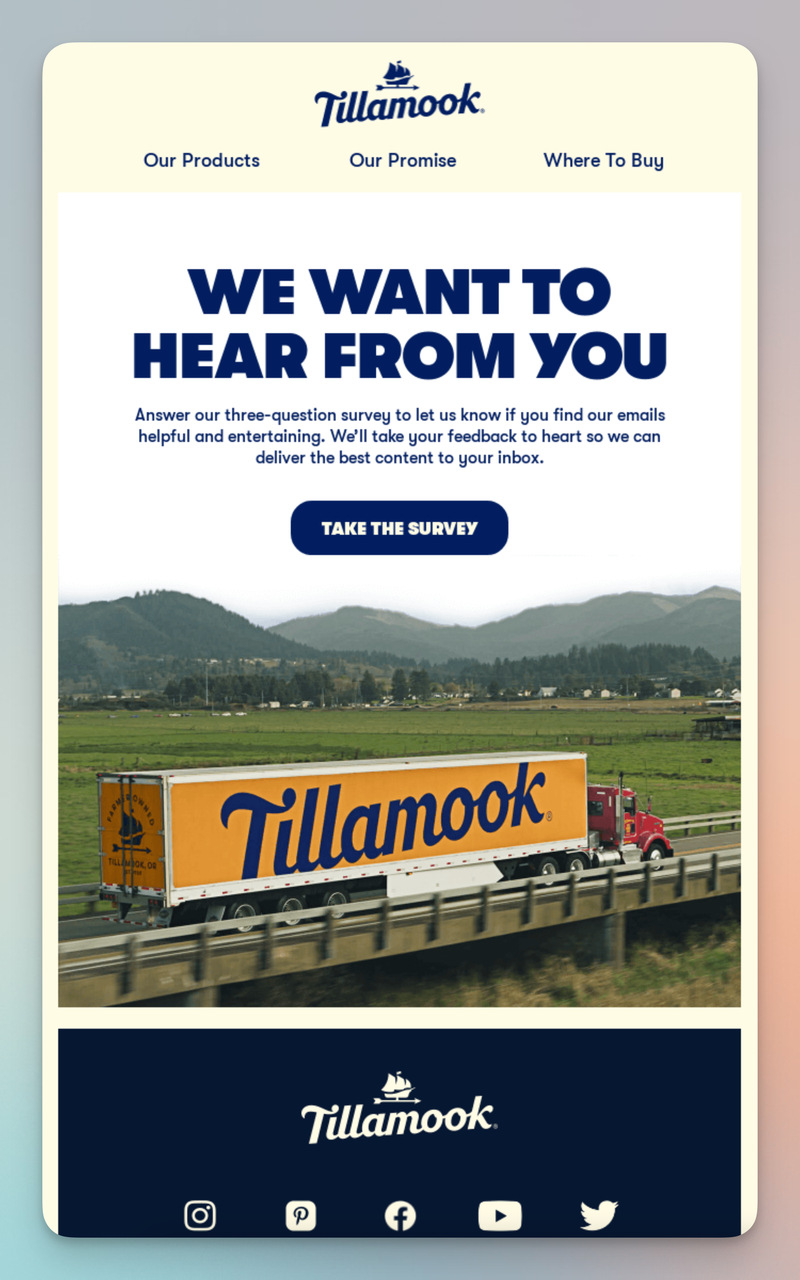
Key elements Magic Spoon uses in its feedback-request email:
- Invitation for Feedback: It invites recipients to participate in a three-question survey. This approach makes it clear that the feedback process will be quick and easy, which is more likely to encourage participation.
- Engagement Incentive: By stating that the feedback will help deliver better content to the subscriber’s inbox, Tillamook provides a reason for the customer to engage. It suggests a benefit to the customer, enhancing the likelihood of their involvement.
Why it's effective? This feedback request email from Tillamook exemplifies how to effectively re-engage customers by making them feel valued and involved in improving the products and services they enjoy.
10. Internal Emails
Internal emails are a critical communication tool within an organization. They ensure information is disseminated efficiently, maintaining transparency throughout the company. These emails can include anything from company news, policy changes, project updates, or HR announcements.
- Company Updates: These emails inform all employees about the company's growth or significant changes. This could include expansion into new markets, acquisitions, changes in leadership, or financial updates. These emails must be clear and concise to ensure everyone understands the progress and direction of the company.
- Project Updates: Project update emails are sent to keep relevant team members updated about the status of a particular project. These emails should detail what has been accomplished, what's in progress, and upcoming tasks or objectives. They help align everyone involved and keep the project moving forward efficiently.
- HR Announcements: Human Resources often need to send emails company-wide to announce changes in policies, company events, employee training opportunities, or changes to employee benefits. They might also need to share regulatory updates that affect employees. This communication allows the HR department to keep everyone updated and ensure information is understood within the company hierarchy.
Critical elements for internal emails:
- Clear Subject Line: Briefly summarize the email's content.
- Concise: Keep the email short and straight to the point.
- Tone: The tone can be formal or casual, depending on your company culture.
- Actionable Content: Clearly state any actions required from the receiver.
- Structure: Use bullet points or subheadings for readability.
- Contact Info: Include details for any necessary follow-ups.
- Sign-Off: End the email with your name and title.
Conclusion: Choosing the Right Type of Email for Your Needs
Choosing the right email to send subscribers is crucial for your marketing strategy. From welcome to transactional emails, each serves a distinct purpose with the ultimate goal of engagement and building relationships with your audience.
Creating an email list is just as crucial as creating emails.
Popups on your website are practical tools for this purpose. They can be simple signup forms or offer incentives like discounts or exclusive content to entice visitors.
Once you have your list, segment it. Popupsmart’s practical and direct segmentation options help you target a custom audience. This allows you to customize your emails based on each subscriber's behavior and preferences, ensuring the right email goes to the right person, which is the key to successful email marketing.
Remember, email marketing is dynamic. Therefore, continually adapt, innovate, and, most importantly, provide value with each email to exploit the full power of email marketing.
Frequently Asked Questions:
How Many Types of Mail Are There?
Businesses can utilize ten main types of emails: welcome emails, onboarding emails, newsletters, promotional emails, seasonal emails, transactional emails, social proof emails, announcement emails, re-engagement/win-back emails, and internal emails.
Each email type includes more than 40 subtypes tailored to fit specific communication needs and customer journey stages.
So, for example, under the primary transactional email type, there are many subtypes, such as order confirmation, password reset, cart abandonment emails, and more.
What Is The Most Popular Type of Email?
Each type of email serves a unique purpose, and the popularity might depend on the objectives of your business and your customers' preferences.
However, newsletters are standard, as they offer a consistent way to engage with your audience regularly.
Other popular types are promotional emails, which directly drive sales, and transactional emails, which deliver necessary information to customers following specific actions like order confirmation or password resets.
But remember, this will largely depend on your business's specific strategy and needs.
Further Reading
Email Marketing Segmentation : The Ultimate Guide
15 Best Browse Abandonment Email Examples to Boost Sales
Customer Retention Email Strategies, Templates & Examples
